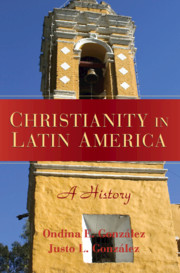Book contents
- Frontmatter
- Contents
- Preface
- Introduction
- 1 Foundations
- 2 The Arrival of Christianity
- 3 The Shaping of the Faith
- 4 Reform Movements
- 5 The Church in Turmoil
- 6 The Church's New Place
- 7 Protestant Immigration
- 8 An Expanding Protestant Presence
- 9 Catholicism after Vatican II
- 10 Pentecostalism and Autochthonous Movements
- 11 By Way of Conclusion
- Some Suggestions for Further Reading
- Sources Referenced
- Index
3 - The Shaping of the Faith
Published online by Cambridge University Press: 05 June 2012
- Frontmatter
- Contents
- Preface
- Introduction
- 1 Foundations
- 2 The Arrival of Christianity
- 3 The Shaping of the Faith
- 4 Reform Movements
- 5 The Church in Turmoil
- 6 The Church's New Place
- 7 Protestant Immigration
- 8 An Expanding Protestant Presence
- 9 Catholicism after Vatican II
- 10 Pentecostalism and Autochthonous Movements
- 11 By Way of Conclusion
- Some Suggestions for Further Reading
- Sources Referenced
- Index
Summary
In 1613, the Christianized indigenous Andean nobleman Don Felipe Guaman Poma de Ayala completed a lengthy one thousand plus page missive, written primarily in Spanish, to King Philip III of Spain, a document the monarch most likely never read. Guaman Poma's hope was to convince the king, and any other Spanish official who might read his words, that colonial officials were destroying the Andes and its people. Toward that end, he wrote of Andean history from creation to the beginning of the seventeenth century and in the process made some interesting links between Andean mythology and Christianity.
As we discussed in Chapter 1, key to the Andean creation myth is the story of Viracocha wandering about disguised as an old beggar. Much like the stories of the Virgin of Caridad del Cobre and the Virgin of Guadalupe, the Viracocha story also underwent a transformation in light of colonial reality, as Guaman Poma's retelling of the tale clearly shows. In Guaman Poma's work, Nueva crónica y buen gobierno (New Chronicle and Good Government), the old, wandering beggar was revealed as the apostle Bartholomew who journeyed to the Andes and there converted pre-Inca peoples to Christianity.
According to Guaman Poma, it was the Incas who had brought idolatry and paganism to the region, squashing any practice of the true faith. (Being from one of the groups conquered by the Incas, it is not at all surprising that Guaman Poma should cast aspersions on those who had robbed his family of its high social ranking.)
- Type
- Chapter
- Information
- Christianity in Latin AmericaA History, pp. 64 - 103Publisher: Cambridge University PressPrint publication year: 2007



